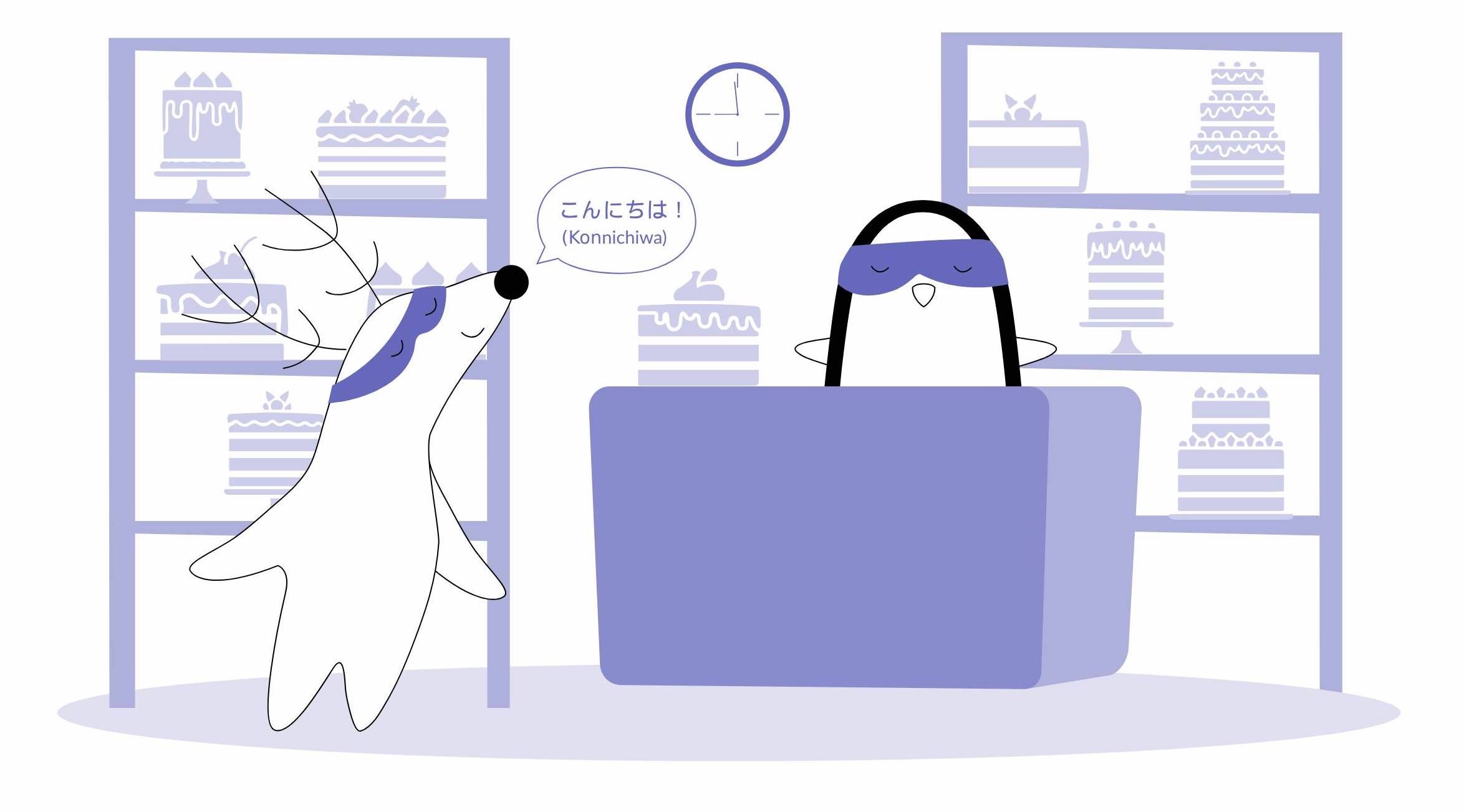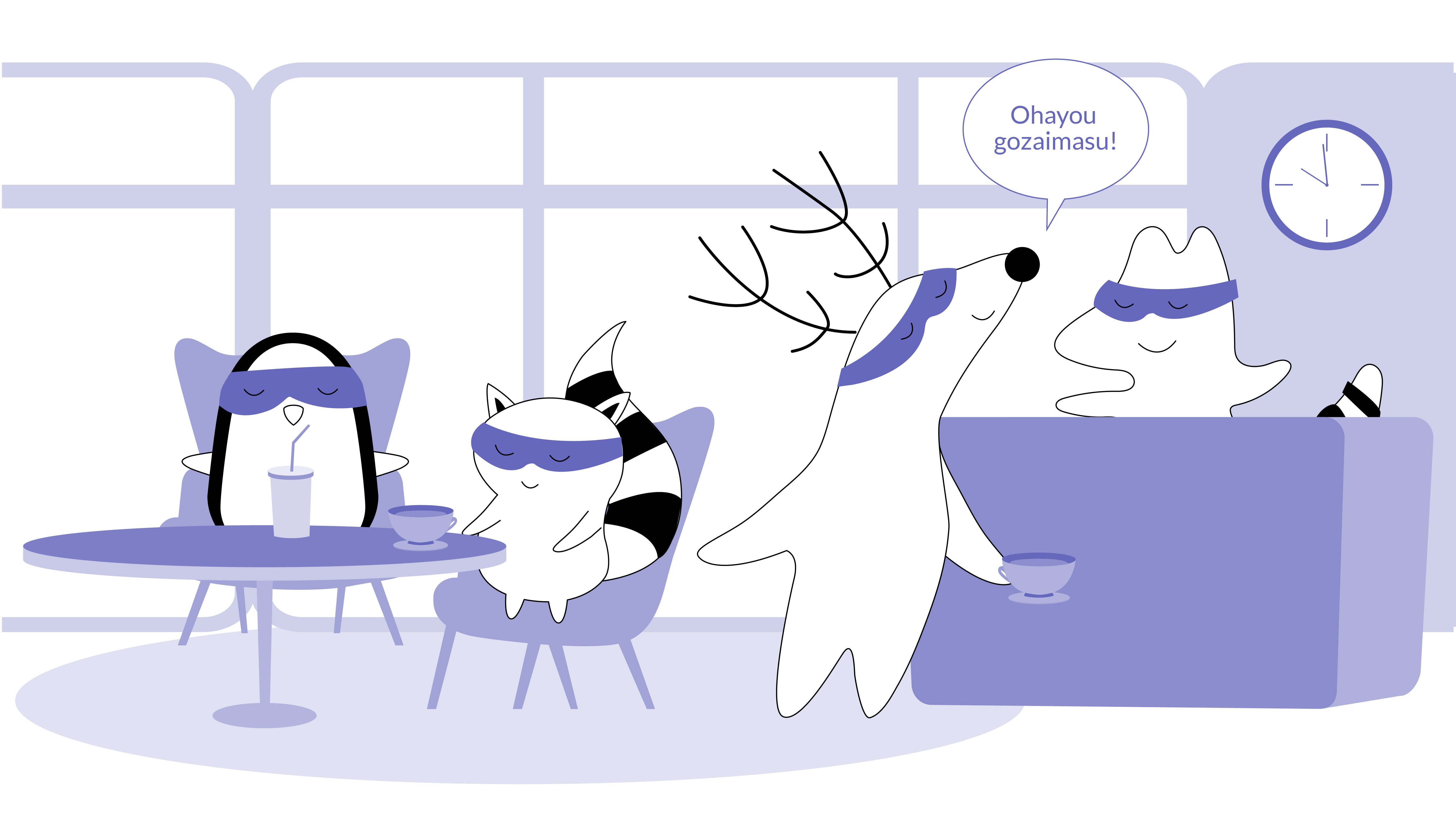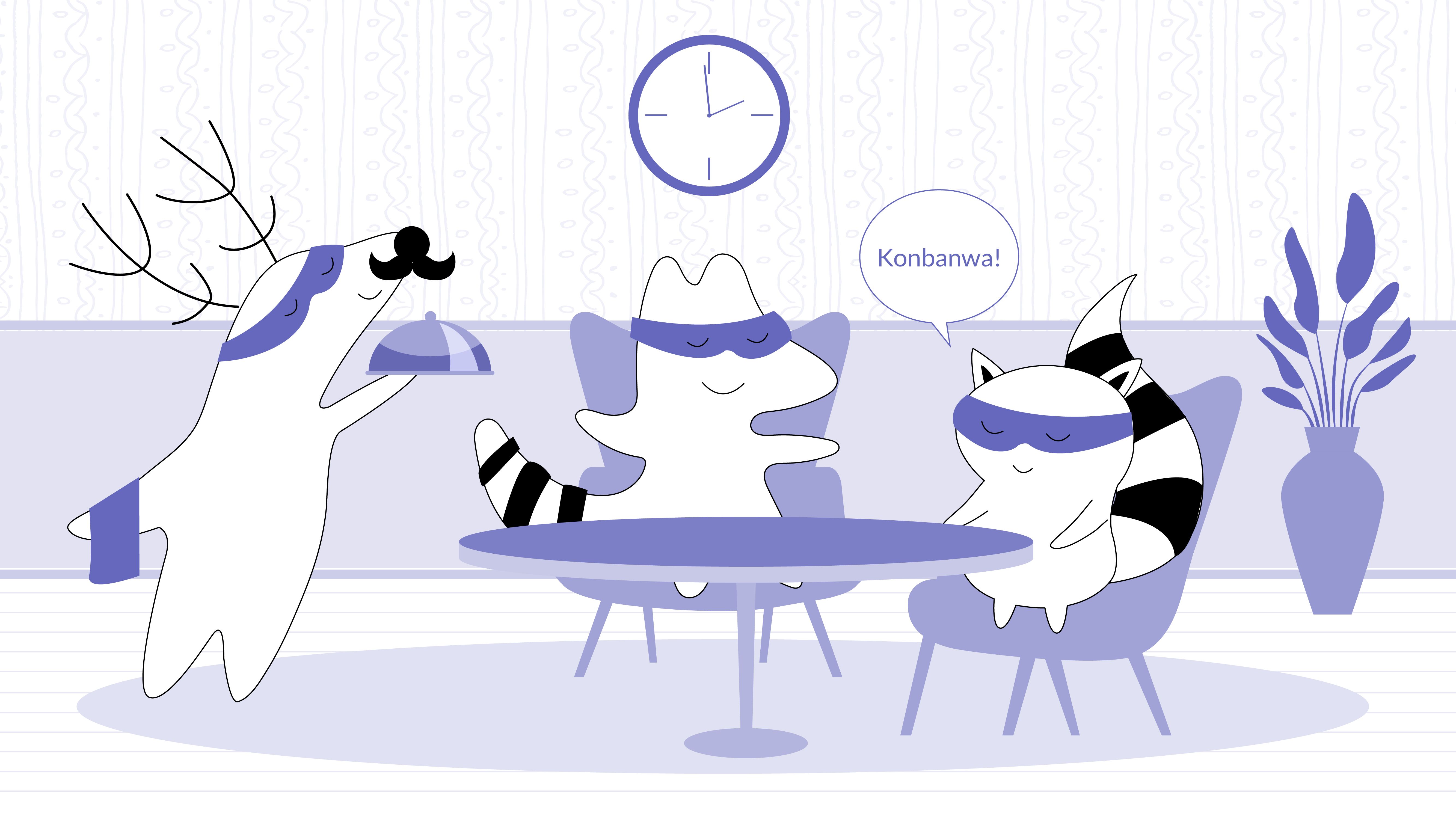
Mastering greetings in any language is the key to making a good first impression and forging meaningful connections. This is especially true in Japanese culture, which significantly emphasizes formality, respect, and social hierarchies within its language.
Whether planning a trip to Japan, learning the language as a hobby, or simply being passionate about the nuances of global languages, understanding how to exchange “hello”s in Japanese is the gateway to deeper cultural understanding and engagement.
In this detailed guide, we'll walk you through the art of saying “hello” in Japanese, uncovering the subtleties of this ancient language, so you can converse with politeness and precision.
From the common phrases like Konnichiwa and Ohayou gozaimasu that pepper everyday interactions in Japan to the cultural underpinnings that give them depth, by the end of this post, you'll know more than just how to say "hello" — you'll understand the thoughtful customs behind it.
Learn languages with stories by Langster
The Significance of Greetings in Japanese Culture
At the heart of Japanese society, greetings are more than just vocal niceties exchanged in passing. They are symbols of respect and an acknowledgment of the other person's status in relation to yours.
Observing these customs speaks volumes and can lead to a smoother, more positively received communication exchange with Japanese people, especially in a setting where formalities are cherished. Therefore, approaching the subject with attention and dedication shows genuine interest and cultural sensitivity.
Japanese greetings are concise and can subtly convey a lot about the speaker's intent and general mood. For instance, the use of polite and formal way -masu, versus casual language without these suffixes, might show that the speaker is being deferential.
Sometimes, even a subtle bow or nod accompanies the verbal greeting, further emphasizing the relationship dynamics at play.
Common Japanese Greetings to Set the Tone
There is an appropriate greeting for every time of day in Japan, and these phrases are ingrained into the daily lives of Japanese people from a very young age.
Here are some of the most prevalent “hello”s you're likely to encounter:
Konnichiwa (こんにちは) — The Standard Way to Say “Hello” in Japanese
Japanese
English
こんにちは
Hello
Used from around 10 a.m. to sunset, Konnichiwa is one of the most recognizable Japanese greetings. It is versatile and often used when unsure which specific time greeting is appropriate.
Konnichiwa (koh-nee-chee-wah), which translates directly to "hello" in English, is the quintessential all-purpose greeting in the Japanese language. Rooted in the term for "today," this greeting historically hints at an inquiry into one's well-being, akin to asking, "How are you today?"
Predominantly used during daylight hours, Konnichiwa gracefully transcends the barriers of social hierarchy, making it suitable for most people in many contexts. However, its versatility is bound by time — as the sun sets, the appropriateness of Konnichiwa fades, leaving it seldom heard in the early morning or late evening.
A quintessential aspect of pronouncing Konnichiwa — or any Japanese word for that matter — revolves around understanding the subtlety of pitch variation. Unlike many languages where syllable stress is prevalent, Japanese pronunciation relies heavily on pitch.
The same sequence of syllables can unveil distinct meanings when articulated with varied pitches. Thus, emulating the exact tones used by native speakers is crucial for accurate pronunciation and understanding.
Ohayou Gozaimasu (おはようございます) — Good Morning
Japanese
English
おはようございます
Good morning

Typically employed until the sun is at its peak, Ohayou gozaimasu (oh-hah-yoh goh-zah-ee-muhss-oo) is the jovial and polite way to start conversations in the morning, reflecting a fresh start to the day.
This greeting serves as a respectful and bright way to initiate conversations whenever you greet friends and family members, address a stranger or someone in a position of authority, or even when parting ways in the early hours. Its use indicates an awareness of the time of day and exhibits respect and politeness towards the person you're speaking with.
The shorter and more casual way of saying it is Ohayou (おはよう) which is used between family, friends, or anyone that you know and are close with. It’s similar to simply saying “Morning!” in English.
Japanese
English
おはよう
Morning!
Transitioning from the initial greeting like Ohayou gozaimasu to Sayonara (sah-yoh-nah-rah), meaning "goodbye," as the day progresses towards the afternoon ensures your Japanese greetings remain contextually appropriate and culturally sensitive.
Japanese
English
さよなら
Sayonara
However, it’s important to mention that fewer and fewer people use Sayonara to say goodbye because this word implies the "never meet again" kind of goodbye and gives a cold feeling at the end.
These days, さようなら almost only appears on two occasions: in the meaning of “Farewell" and in school-related contexts — people still use Sayonara as a formal way of saying goodbye to teachers and classmates.
Other, more common ways of saying goodbye are:
Japanese
English
じゃね
Ciao!
またね
See you later.
バイバイ
Bye-bye.
Konbanwa (こんばんは) — Good Evening
Japanese
English
こんばんは
Good evening

When the day transitions into evening, Konbanwa (kohn-bahn-wah), meaning “good afternoon” or "good evening" in English, becomes the appropriate greeting. This versatile phrase is suitable for use when you're meeting someone in the late afternoon or as the night unfolds.
Unlike Konnichiwa, which is confined to daylight hours, Konbanwa is both a greeting and a farewell under the veil of night. This is particularly relevant in Japanese culture, where the distinction between day and evening carries significant social importance, mirroring interactions' formal and respectful nature.
In instances of parting ways at night, transitioning from Konbanwa to Oyasumi nasai (oh-yah-soo-mee nah-sigh), or "good night", signifies more than just a goodbye; it is a wish for a peaceful rest, reserved exclusively for these moments.
Japanese
English
おやすみなさい
Good night
Remember, Oyasumi nasai is never used to greet someone, only in departure. Its pronunciation carries the respectful acknowledgment of the day's end.
Cultural Note:
The precise segmentation of day into morning, afternoon, and evening in Japanese culture emphasizes the importance of using the correct greetings at different times of the day.
While in Western contexts, "hello" might suffice for any time and both as a formal and informal greeting, in Japan, mistaking Konnichiwa for a morning or night greeting could be seen as a lack of cultural understanding.
Observing these distinctions when learning Japanese is a great sign of respect and an integral part of effective communication and cultural appreciation in Japan.
O Genki Desu Ka (お元気ですか) — How Are You?
Japanese
English
お元気ですか
How are you?
Once the initial greetings are exchanged, a thoughtful way to continue the conversation is by asking, O genki desu ka (oh gehn-kee dehss kah), which translates to "How are you?" in English.
This question is polite and respectful, particularly towards older individuals or those who hold a certain level of authority. In Japanese culture, where respect and etiquette are paramount, asking about someone's well-being in such a manner is highly regarded.
Besides, it's an excellent conversation starter and a means to show genuine interest in the person's life. It does more than inquire about one's health; it conveys care and a desire to engage in meaningful interaction.
Should someone ask you this question, the appropriate and formal phrase to reply with is O kagesama de genki desu (おかげさまで元気です), meaning "Thank you, I'm fine."
Japanese
English
おかげさまで元気です
Thank you, I'm fine
This exchange adheres to cultural norms and fosters a connection between Japanese speakers, demonstrating mutual respect and interest in each other's well-being.

Moshi Moshi (もしもし) — How to Say “Hello” in Japanese Over the Phone
Japanese
English
もしもし
Hello! (on the phone)
In the nuanced world of Japanese greetings, Moshi Moshi, standing distinct for its use exclusively over the phone, offers a fascinating insight into cultural specificity.
Unlike English, where you can use the same greeting regardless of the medium, Japanese delineates between face-to-face interactions and those occurring telephonically. Whether initiating a call or responding, Moshi Moshi (moh-shee moh-shee) is customary to greet someone on the phone.
This tradition underscores the importance of context in Japanese communication, emphasizing that one should never use Moshi Moshi to greet someone in person; doing so would likely result in confusion or amusement.
Pronunciation Note: The swift pace of conversation in Japanese often leads to a rapid delivery of Moshi Moshi, compressing it to sound more like mohsh mohsh. With the last syllable barely articulated, this abbreviation highlights that it’s a fluid and very casual way of speaking reserved for telephonic conversations only.

Practical Tips for Mastering Japanese Greetings
Whether you're a beginner in your Japanese language learning journey or seeking to refine your existing language skills, there are several practical tips that can help you confidently greet people in Japanese:
Pronunciation Essentials
Japanese has a relatively simple set of sounds. However, it’s important to pronounce each syllable clearly and evenly.
For instance, Ohayou gozaimasu should be broken down into ohayo (Oh-high-yo) and gozaimasu (goh-zah-ee-mah-soo).
Timing Is Everything
Knowing precisely when to use each greeting is crucial. Employ Konnichiwa when you're unsure of the proper time, but don’t greet a stranger with a morning greeting late into the afternoon.
Use Honorary Titles with Care
When addressing others, be mindful of using the appropriate honorifics, such as:
- San (Mr./Ms.),
- Sama (for people of higher status),
- Sensei (teacher/master).
Be Wary of Greetings in Passing
Unlike in some cultures, where passing greetings are often informal or even non-verbal, in Japan, respectful verbal greetings are important, even in passing encounters.
Common Mistakes to Avoid When Saying “Hello” in Japanese
For non-native speakers, certain mistakes can inadvertently come off as disrespectful or inappropriate. Here's a rundown of common faux pas to dodge:
Too Casual in Formal Settings
Mismatching the formality level in speech to the social setting can be considered rude, jarring, or even offensive. Always lead with a higher level of formality until invited to be more casual.
Overexerting Formality
On the flip side, using more formal greetings when they aren't called for can make you seem distant or standoffish. Gauge the context and try to match the level of formality to the situation.
Misuse of Honorifics
Addressing someone with the wrong honorific, or not using any at all, can convey unintentional disrespect. Take care with these, as they carry weight in Japanese communication.
Ignoring the Role of Body Language
In Japan, body language is as important as verbal language. Failing to bow appropriately or maintaining inappropriate eye contact can detract from the sincerity of your verbal greetings.
Reaping the Rewards of Polished Japanese Greetings
By committing to understanding and using Japanese greetings with care and respect, you'll be more effective at navigating conversations and relationships and open up opportunities for enriched cultural exchanges.
Learning to say “hello” in Japanese is just the beginning; as you continue your language learning, you’ll find that every phrase carries its own history, context, and emotional resonance. Start with these greetings, master them, and then watch as the doors of courtesy and connection swing open for you.
To enhance your learning experience, download our Langster app to learn Japanese with stories and practice common greetings in context! This way, whether talking to close friends of the same age or an older family member, you’ll know how to address each person properly.
Learn languages with stories by Langster







